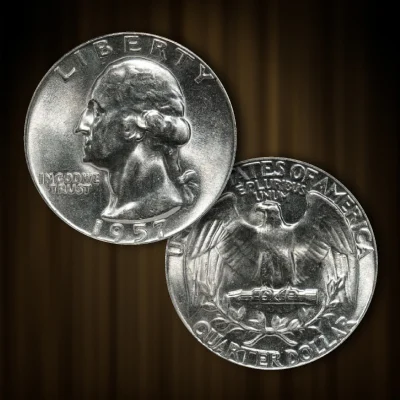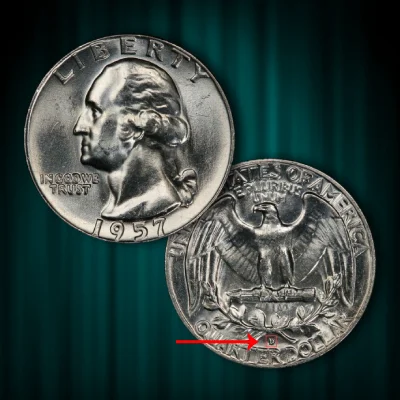Have you ever held a coin and wondered what its story was? Coins are more than simply pieces of metal; they are small
time capsules that preserve the legacy of their era. Among the many coins jingling in pockets, the 1957 quarter
stands out to collectors and enthusiasts alike.
So, how much is a 1957 Quarter worth today?
While it has a face value of only 25 cents, its current value might much exceed the number printed on the surface.
Whether it's the historical fascination, the dazzling silver content, or the possibility of rarity, this little
piece of history could hold a surprising wealth.
Are you ready to unravel the secrets of your 1957 quarter value?
Let's dive in!
1957 Quarter Value and Varieties
Have you ever held a coin and wondered what its story was? Coins are more than simply pieces of metal; they are small
time capsules that preserve the legacy of their era. Among the many coins jingling in pockets, the 1957 quarter
stands out to collectors and enthusiasts alike.
So, how much is a 1957 Quarter worth today?
While it has a face value of only 25 cents, its current value might much exceed the number printed on the surface.
Whether it's the historical fascination, the dazzling silver content, or the possibility of rarity, this little
piece of history could hold a surprising wealth.
Are you ready to unravel the secrets of your 1957 quarter value?
Let's dive in!
1957 Quarter Value and Varieties
1957 Quarter value can be more than you think. The table below shows the approximate value for the 1957 quarters;
however, they are not the standard values.
| 1957 No-Mint Mark Quarter |
$9.72 |
$9.72 |
$9.72 |
$13 |
| 1957-D Quarter |
$9.72 |
$9.72 |
$9.72 |
$13 |
| 1957 Proof Quarter |
- |
- |
- |
$150 |
The 1957 quarter value varies according to the condition. These quarters have many varieties.
1) 1957 No-Mint Mark Quarter

In 1957, approximately 46,532,000 Washington quarters were struck by the Philadelphia Mint. The quarters
arriving
from Philadelphia that year were badly struck since mint employees continued to use old or repolished dies
from
1956.
To improve the strike, the mint experimented with last year's proof dies. Because proof dies were used rather
than
ordinary dies, the reverse of many 1957 quarters without a mint mark is slightly brighter with crisper
details,
while the obverse is dull with a poor strike. At $7 to $9, circulated 1957 no-mint mark quarters are
reasonably
priced.
Uncirculated samples are also reasonably priced; a quarter with MS63 grade costs around $15, but quarters
graded
MS67, which are extremely uncommon and can sell for up to $100, can cost much more.
-
If you are fortunate enough to find a gem-quality 1967
no-mint mark quarter (rated MS67 and higher),
be ready
to either spend a lot of money or sell the coin for a good profit.
-
The most costly 1957 no-mint mark quarter to date was an MS68 that brought $3,819 in a Heritage
Auctions sale
in 2012.
2) 1957-D Quarter Value

In 1957, the Denver Mint produced the most Washington quarters since 1944, with approximately 77,924,160
being
struck.
Gems broken from previously hoarded rolls that are rated MS67 and higher are easily accessible. The value of
a 1957
silver quarter in circulation ranges from $7 to $9. These coins are collectible because, similar to the
Philadelphia
quarters, their price is far more than their face value.
• In an uncirculated condition, the 1957-D quarters are considerably more
valuable; an MS67 piece can
get up to
$200.
• Paying $11,400 for an MS68 1957-D quarter at a 2021 Stack's Bowers
auction, a
collector shattered the
record,
according to the Professional Coin Grading Service.
3) 1957 Proof Quarter Value

The Philadelphia Mint created proof coins for collectors in addition to the standard strike coins. In 1957,
the
factory produced an estimated 1,247,952 proof quarters, a notably large mintage that resulted in a decline
in coin
quality.
Collectors over ordered proof sets in 1957 as a result of the 1956 proof set speculation, and the Mint,
therefore,
minted more coins to satisfy the demand. The 1957 proof quarters exhibit signs of worn or over-polished
dies,
despite the fact that proof coins are meant to have excellent strike, brilliant luster, and remarkable
visual
appeal.
It is quite difficult to get fully dazzling proofs since the deep cameo population is so small, even if they
are
prevalent up to grade PF69.
-
While the uncommon deep cameo can sell for as much as $12,500, as was the case with a PF69DCAM sold
at a 2023
Stack's Bower auction, a 1957 quarter proof will often bring approximately $140.
These are some popular varieties of 1957 quarters. Although the worth of these quarters depends upon
condition, some
1957 quarters with errors are worth more.
Let's look upon rare 1957 quarter errors:
Rare 1957 Quarter Errors
1) 1957 Misplaced Mint Mark Quarter Error
Though mint employees usually take care to apply mint markings in the proper location, misplaced mint mark errors are
rare. QUARTER DOLLARS normally have the D mint mark between E and R on the reverse.
However, the mint mark appears to be a little out of alignment and is oriented closer toward the R in 1957. Depending
on the coin's condition, such a mistake may sell for anywhere between $200 and $270.
2) 1957 Repunched Mint Mark Quarter Error
When the punching die hits the mint mark more than once, the mark seems to double, which is known as a repunched mint
mark error. The mint mark can also be filled in by this multiple hitting. High-mintage series frequently have mint
mark defects; a 1957 repunched mint mark error can fetch up to $75 from enthusiasts.
3) 1957 Type B Reverse Proof Strike Error
In the Washington quarter series from 1957, this is the most frequent mistake. Quarters from 1957 were struck using
proof dies on the back and normal dies on the front. This mistake might have happened because the Philly Mint's
employees used proof dies to strike coins because the normal dies were so poor. At least $200 can be earned from a
type B reverse-proof strike error, which is highly desirable.
Conclusion
Due to its history, silver content, and collectible variations, the 1957 Quarter is worth more than its face
value.
High-quality, uncirculated 1957 quarters can sell for anywhere from $15 to over $11,000, while circulated ones
can
sell for $7 to $9.
Its value can also be greatly increased by proof quarters and uncommon mint mistakes, such as the Type B reverse
error or the missed mint mark. Investigating the 1957 Quarter Value can uncover a hidden gem in your possession,
regardless of your level of interest in collecting.
So if you are worrying about the 1957 quarter value, forget your worries and get ready to earn profits from 1957
quarters.
FAQs
Is a 1957 quarter made out of silver?
Yes, 90% silver and 10%
copper were used to make 1957 Washington quarters. They are valuable as investments in
bullion and as collectibles because of their composition.
How much does a 1957 silver quarter weigh?
The 1957 silver quarter weighs between 6.25 and 6.35 grams.
